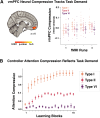Coordinating multiple mental faculties during learning
- PMID: 39939457
- PMCID: PMC11822098
- DOI: 10.1038/s41598-025-89732-4
Coordinating multiple mental faculties during learning
Abstract
Complex behavior is supported by the coordination of multiple brain regions. How do brain regions coordinate absent a homunculus? We propose coordination is achieved by a controller-peripheral architecture in which peripherals (e.g., the ventral visual stream) aim to supply needed inputs to their controllers (e.g., the hippocampus and prefrontal cortex) while expending minimal resources. We developed a formal model within this framework to address how multiple brain regions coordinate to support rapid learning from a few example images. The model captured how higher-level activity in the controller shaped lower-level visual representations, affecting their precision and sparsity in a manner that paralleled brain measures. In particular, the peripheral encoded visual information to the extent needed to support the smooth operation of the controller. Alternative models optimized by gradient descent irrespective of architectural constraints could not account for human behavior or brain responses, and, typical of standard deep learning approaches, were unstable trial-by-trial learners. While previous work offered accounts of specific faculties, such as perception, attention, and learning, the controller-peripheral approach is a step toward addressing next generation questions concerning how multiple faculties coordinate.
© 2025. The Author(s).
Figures




References
-
- Locke, J. An essay concerning human understanding. Read. Hist. Psychol.1, 55–68 (1960).
-
- Hume, D. An enquiry concerning human understanding. Essays and treatises on several subjects, Vol 2: Containing An enquiry concerning human understanding, A dissertation on the passions, An enquiry concerning the principles of morals, and The natural history of religion. 3–212 (1779). /record/2008-16196-001.
-
- Kieras, D. E. An overview of the EPIC architecture for cognition and performance with application to human-computer interaction. Human-Comput. Interact.12, 391–438 (1997) (/record/1998-00672-004.).
-
- Young, R. M. & Lewis, R. L. The Soar Cognitive Architecture and Human Working Memory. Models Work. Memory 224–256 (1999). /record/1999-02490-006
-
- Anderson, J. R., Michael, M. & Lebiere, C. ACT-R: A theory of higher level cognition and its relation to visual attention. Human-Comput. Interact.12, 439–462 (1997).
MeSH terms
Grants and funding
LinkOut - more resources
Full Text Sources

